Vespersaurus paranaensis – A Desert Dwelling Dinosaur
Roaming the Late Cretaceous of Brazil some 90 to 85 million years ago, was a little, fast-running, carnivorous dinosaur with a unique way of getting about. The dinosaur has been named Vespersaurus paranaensis and at an estimated length of just over a metre (maximum length 1.6 metres), this was no giant, but its discovery will help scientists to work out the taxonomic relationships amongst an obscure group of theropods known mainly from Gondwana and provide new insight into theropod locomotion.
Vespersaurus paranaensis
Writing in the academic journal “Scientific Reports”, the researchers suggest that Vespersaurus supported its weight on just one digit (metatarsal III and toe III), it may have been essentially monodactyl i.e. it had one main, central weight-bearing toe. The other toes associated with support and weight bearing in the Theropoda (digits II and IV), were very much smaller and may even have been held off the ground.
A Life Reconstruction of the Newly Described Brazilian Theropod Vespersaurus paranaensis
Picture credit: Rodolfo Nogueira
Affinities with the Abelisauroidea
Analysis of the fossil material, which includes vertebrae, elements from the pelvis and limbs along with fragmentary skull bones suggests that this little dinosaur is a member of the Abelisauroidea, specifically the Noasaurinae, an enigmatic subfamily collectively known from sparse fossil material mostly from southern latitudes. For example, Vespersaurus has the reduced forelimbs which are characteristic of the abelisaurids and it is hoped that these fossils will help palaeontologists to better understand the phylogeny of these Late Cretaceous predators.
Although only about 40% of the skeleton is known, these fossils represent one of the best examples of a member of the Noasauridae family found to date and the most complete dinosaur specimen from the whole of the Bauru Sub-basin. It is also the first dinosaur to be described from rocks that constitute part of this basin, the Caiuá Group.
Frontal (Skull Bone) and Views of an Isolated Tooth (Vespersaurus paranaensis)
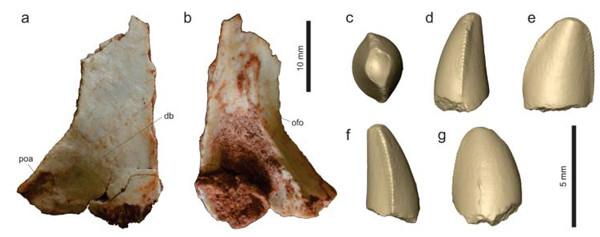
Picture credit: Scientific Reports (Langer et al)
A Late Cretaceous Desert Environment
The majority of the strata making up the Caiuá Group represent sandstones that were deposited by the action of wind (aeolian deposits). During the Late Cretaceous, this region of Gondwana was an extensive desert. The fossil record is particularly sparse with only a handful of animals recorded from what probably would have been oases. Arguably, the most famous fossils from this part of the world represent a pterosaur monodominant bonebed (Caiuajara dobruskii). Other than Caiuajara and this new dinosaur, the only other vertebrate fossils known from this area represent a lizard and a turtle.
Pectoral Elements and Limb Bones (V. paranaensis)
Picture credit: Scientific Reports (Langer et al)
To read about Caiuajara: New Species of Flying Reptile Identified from Pterosaur Graveyard.
Strange Footprints
Examination of the foot bones and toes suggests that this dinosaur supported its weight on just a single, central digit. Such an anatomical adaptation (a monodactyl stance), has not been recorded in the Archosauria before, but such a form of locomotion had been inferred by palaeontologists as numerous footprints indicating an enlarged weight-bearing toe in a theropod dinosaur have been found in rocks of the same age as the sediments that yielded the fossils of Vespersaurus.
A Close Up of the Foot Showing the Weight-bearing Toe
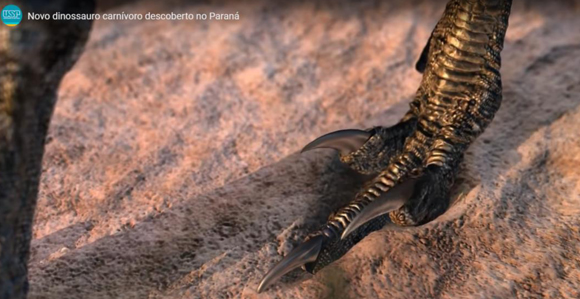
Video image credit: Universidade de Sáo Paulo et al
Helping to Classify the Noasaurinae
The Noasaurinae are a branch of the Abelisauroidea consisting of small, predatory theropods known from Upper Cretaceous strata mostly associated with Gondwana (southern latitudes). Perhaps the best known noasaurid is Masiakasaurus knopfleri, from the latest Cretaceous (Maastrichtian) of Madagascar, but two other taxa from Argentina described from relatively fragmentary fossil material have been assigned to the Noasaurinae (Noasaurus leali and Velocisaurus unicus).
Other dinosaurs from outside South America have also been tentatively assigned such as an as yet, unnamed specimen from India, Deltadromeus agilis from Morocco and Genusaurus sisteronis from France. It is hoped that this more complete fossil specimen will permit palaeontologists to better understand taxonomic relationships within the Noasaurinae and their wider placement within the Abelisauroidea.
Building a Family Tree of the Abelisauroidea
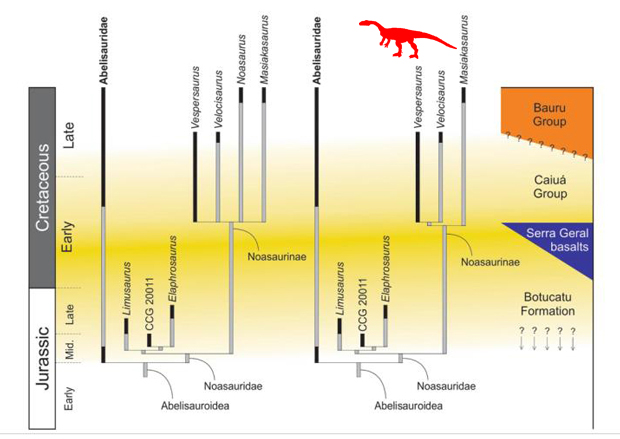
Picture credit: Scientific Reports (Langer et al)
Etymology of Vespersaurus paranaensis
The generic name derives from the words “vesper” (Latin for evening/west) and “sauros” (Greek for lizard/saurian), in reference to the name of the town Cruzeiro do Oeste (Western Cross), where the fossils were found. The specific epithet refers to the Paraná state, the authors report that V. paranaensis represents the first non-avian dinosaur from that area of Brazil.
The scientific paper: “A new desert-dwelling dinosaur (Theropoda, Noasaurinae) from the Cretaceous of south Brazil” by Max Cardoso Langer, Neurides de Oliveira Martins, Paulo César Manzig, Gabriel de Souza Ferreira, Júlio César de Almeida Marsola, Edison Fortes, Rosana Lima, Lucas Cesar Frediani Sant’ana, Luciano da Silva Vidal, Rosangela Honório da Silva Lorençato and Martín Daniel Ezcurra published in the journal Scientific Reports.
The Everything Dinosaur website: Everything Dinosaur.


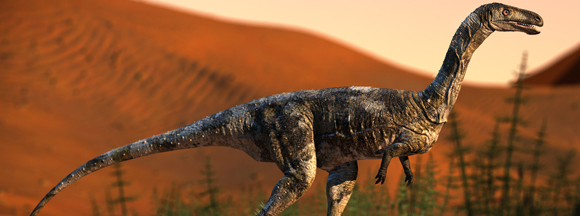
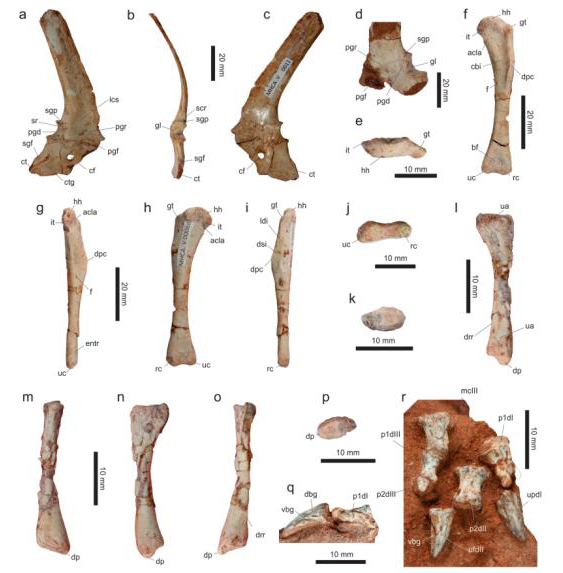




Leave A Comment